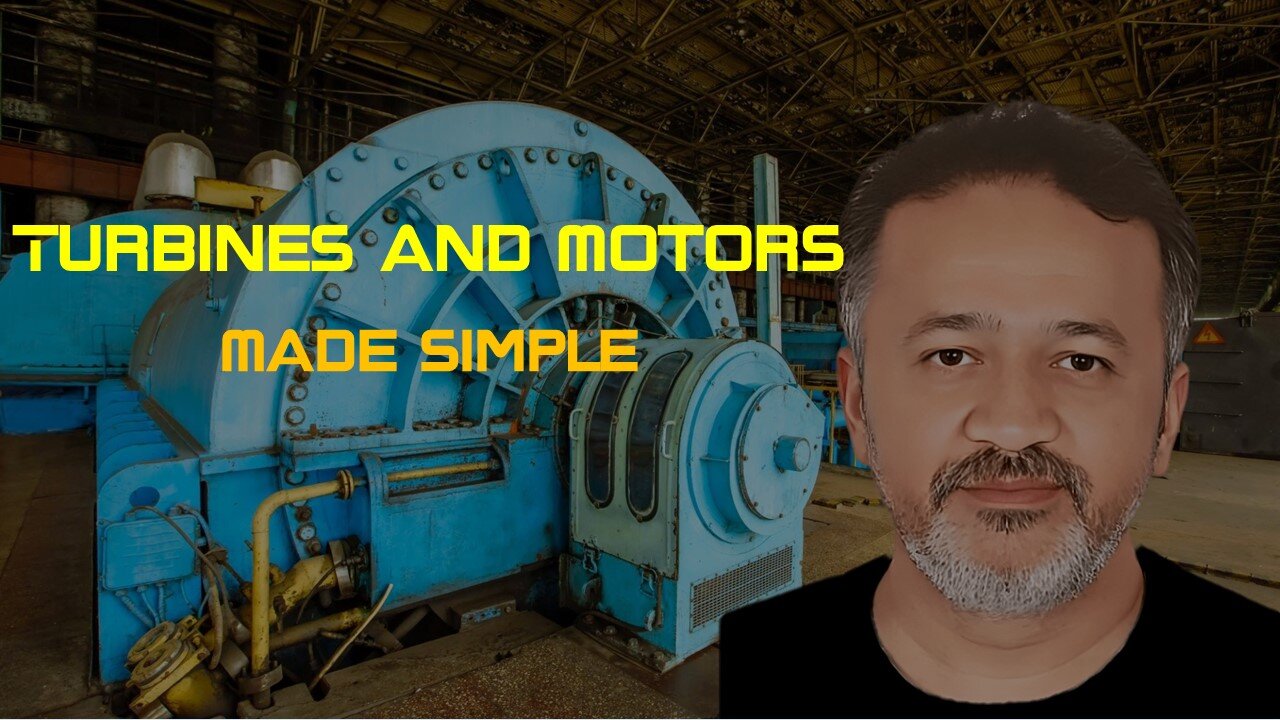Premium Only Content

Turbines Made Simple |Turbines and Motors Demystified: How They Work and Their Applications
Turbines and motors are mechanical devices that convert energy from one form to another to perform useful work. They play a crucial role in various industries, transportation systems, and power generation.
Turbines:
Turbines are machines that extract energy from a fluid flow (usually air, steam, or water) and convert it into rotational mechanical energy. They consist of blades or vanes mounted on a rotor that spins when the fluid flows over or through them. The rotation of the turbine can be harnessed to generate electricity, produce thrust, drive machinery, or power other mechanical systems. Turbines are widely used in power plants for electricity generation, aviation for propulsion, and industries such as oil and gas, water treatment, and manufacturing.
Motors:
Motors are devices that convert electrical energy into mechanical energy. They utilize the principles of electromagnetism to generate a rotating magnetic field, which interacts with conductive coils or magnets to produce rotational motion. Motors are essential for driving machinery, appliances, vehicles, and various industrial processes. Common types of motors include:
Electric Motors: Electric motors are widely used in applications ranging from small household appliances to large industrial machinery. They operate on the principle of electromagnetic induction, where the interaction between a stationary magnetic field and a rotating coil produces mechanical rotation.
DC Motors: Direct current (DC) motors convert direct current electrical energy into mechanical motion. They are commonly used in battery-powered devices, electric vehicles, and applications requiring precise speed control.
AC Motors: Alternating current (AC) motors convert alternating current electrical energy into rotational motion. AC motors are widely used in industrial applications and household appliances, including fans, pumps, compressors, and HVAC systems.
Induction Motors: Induction motors are the most commonly used type of AC motor. They rely on electromagnetic induction to produce a rotating magnetic field in the rotor, allowing the motor to rotate. Induction motors are durable, reliable, and have a wide range of applications.
Synchronous Motors: Synchronous motors operate at a fixed speed, synchronized with the frequency of the power supply. They are commonly used in applications where precise speed control is required, such as in industrial machinery, clocks, and synchronous generators.
Turbines and motors are critical components in various industries and sectors, enabling the conversion of energy into mechanical power. They provide the necessary force and motion to drive machinery, generate electricity, propel vehicles, and power countless applications that contribute to our modern way of life.
-
 2:53:01
2:53:01
Jewels Jones Live ®
1 day agoA MAGA-NIFICENT YEAR | A Political Rendezvous - Ep. 103
121K32 -
 29:54
29:54
Michael Franzese
14 hours agoCan Trump accomplish everything he promised? Piers Morgan Article Breakdown
117K49 -
 2:08:19
2:08:19
Tactical Advisor
18 hours agoThe Vault Room Podcast 006 | Farwell 2024 New Plans for 2025
187K11 -
 34:12
34:12
inspirePlay
1 day ago $5.65 earned🏆 The Grid Championship 2024 – Cass Meyer vs. Kelly Rudney | Epic Battle for Long Drive Glory!
87.2K8 -
 17:50
17:50
BlackDiamondGunsandGear
15 hours ago $2.98 earnedTeach Me How to Build an AR-15
61.4K6 -
 9:11
9:11
Space Ice
1 day agoFatman - Greatest Santa Claus Fighting Hitmen Movie Of Mel Gibson's Career - Best Movie Ever
119K48 -
 42:38
42:38
Brewzle
1 day agoI Spent Too Much Money Bourbon Hunting In Kentucky
80.6K13 -
 1:15:30
1:15:30
World Nomac
1 day agoMY FIRST DAY BACK in Manila Philippines 🇵🇭
62.6K9 -
 13:19
13:19
Dr David Jockers
1 day ago $11.81 earned5 Dangerous Food Ingredients That Drive Inflammation
81.3K17 -
 1:05:13
1:05:13
FamilyFriendlyGaming
1 day ago $15.95 earnedCat Quest III Episode 8
131K3